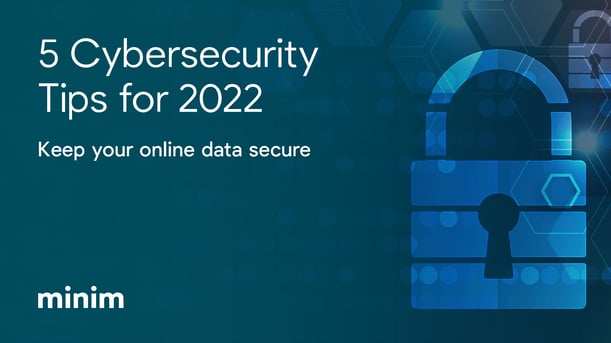5 Cybersecurity Tips for 2022
At Minim, we practice cybersecurity awareness 365 days a year but October is a particularly relevant month to discuss online safety, as it’s Cybersecurity Awareness Month! While the world has returned to a certain sense of normalcy in 2022, the data scientists at Ladders project that nearly 25% of all professional jobs in the US will be remote by the end of the year. As the prevalence of remote work continues to rise, so does the risk of experiencing a cyberattack and although technology plays a critical role in cybersecurity, people are the ultimate line of defense.
That’s why we decided to take the opportunity during Cybersecurity Awareness Month to share some educational materials that can keep you and your family safe online now and in the years to come. Keep reading below for some best practices in staying #cybersecure.
Tip 1: Install antivirus/anti-malware protection
You can never truly be protected from malware if you’re connected to the internet. However, you can significantly reduce your susceptibility to cyberattacks by making sure you have anti-virus and anti-malware software installed on your computer. Just be sure to only install these programs from a trusted source and always keep them up-to-date to ensure they remain effective.
Also using tools like the motosync app powered by Minim, you can also enjoy advanced cybersecurity features like auto firmware updates and malware scans.
Tip 2: Do NOT click unknown links
This one might seem obvious, but you’d be surprised how many people still click unknown links and end up compromising their private information. Whether it’s sent through text, email, or any other digital message, do NOT click any link that seems suspicious to you—especially if you don’t recognize the sender. This is the oldest trick in the book and sadly so many people fall into this trap, mostly from clicking links sent through text messages.
Tip 3: Practice good password management
Many of us are guilty of reusing the same password over and over. However, it’s best to switch up your password for different accounts and change them every few months. This will help keep cybercriminals from accessing all of your data since you’re not using the same password for everything and slow their progress when you reset your passwords.
For extra security, you can also enable multiple-factor authentication on all your accounts. That way if they guess your password, they still won’t be able to hack into your account without access to the additional security codes and alerts that typically deliver to your mobile device or personal email.
Tip 4: Be careful on mobile devices
People sometimes forget that good cybersecurity habits aren't just for your desktop. Make sure you’re keeping your mobile devices protected by:
- Locking your device with a PIN or password.
- Keeping your software and firmware up-to-date.
- Avoiding suspicious links, messages, and attachments from unknown senders.
- Only install apps from trusted sources.
- Not sharing important personal information over the phone (credit card info, social security numbers, etc.).
- Making sure your device literally never gets in the wrong hands.
Tip 5: Backup your data
If you ever are the victim of a security breach, it’s critical to make sure you’re prepared to restore important data to avoid a total loss. Ensure your information is backed up regularly on the cloud or a local storage device just in case you ever need to restore it. Without backing up your data, the only guaranteed way to repair your computer after a security incident is to erase and reinstall the system.
These are just a few of the many tips you can use to protect yourself from online threats. It’s important to stay educated on the best cybersecurity practices in order to keep your and your family’s personal information safe. Be sure to follow new posts on our blog to stay up to speed with more cybersecurity tips, product updates, and more!